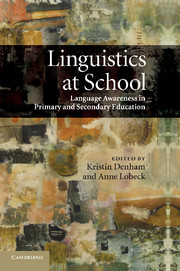Book contents
- Frontmatter
- Contents
- Notes on contributors
- Foreword: The challenge for education
- Introduction
- Part I Linguistics from the top down: encouraging institutional change
- Introduction to Part I
- 1 Ideologies of language, art, and science
- 2 Bringing linguistics into the school curriculum: not one less
- 3 How linguistics has influenced schools in England
- 4 Supporting the teaching of knowledge about language in Scottish schools
- 5 Envisioning linguistics in secondary education: an Australian exemplar
- 6 Linguistics and educational standards: the California experience
- 7 Developing sociolinguistic curricula that help teachers meet standards
- 8 Linguistic development in children's writing: changing classroom pedagogies
- Part II Linguistics from the bottom up: encouraging classroom change
- Part III Vignettes: voices from the classroom
- References
- Index
8 - Linguistic development in children's writing: changing classroom pedagogies
Published online by Cambridge University Press: 04 August 2010
- Frontmatter
- Contents
- Notes on contributors
- Foreword: The challenge for education
- Introduction
- Part I Linguistics from the top down: encouraging institutional change
- Introduction to Part I
- 1 Ideologies of language, art, and science
- 2 Bringing linguistics into the school curriculum: not one less
- 3 How linguistics has influenced schools in England
- 4 Supporting the teaching of knowledge about language in Scottish schools
- 5 Envisioning linguistics in secondary education: an Australian exemplar
- 6 Linguistics and educational standards: the California experience
- 7 Developing sociolinguistic curricula that help teachers meet standards
- 8 Linguistic development in children's writing: changing classroom pedagogies
- Part II Linguistics from the bottom up: encouraging classroom change
- Part III Vignettes: voices from the classroom
- References
- Index
Summary
Introduction
The role of linguistics in writing instruction is a contentious issue. Both in the classroom and at policy level, the subject of ‘grammar teaching’ almost inevitably raises professional or political hackles. As a writer, my choice of the noun ‘linguistics’ in the opening sentence is deliberate, a way of positioning myself as author with a stance of academic respectability. ‘Linguistics’ confers a different status on the topic and would allow me, if I chose, to neatly side-step the negative associations which frequently attend the word ‘grammar’. In the UK in the 1980s, the phrase ‘knowledge about language’ was used as a lexical choice to mediate between political efforts to re-introduce grammar teaching and professional resistance to the idea. Right-wing politicians saw the demise of grammar teaching during the 1960s and 1970s as indicative of a decline in standards; and, at its most extreme, politicians made a link between educational standards and moral standards. Conservative politician Norman Tebbitt, in a BBC radio interview in 1985, argued that allowing standards to slip to a position where “good English is no better than bad English” invidiously eroded the nation's moral standards to the point where there was “no imperative to stay out of crime” (BBC Radio 4, 1985, quoted in Cameron 1995: 94). Perhaps not surprisingly, teachers rejected spurious connections between grammar and moral turpitude, and saw efforts to re-introduce grammar as a return to sterile, ineffective modes of teaching.
- Type
- Chapter
- Information
- Linguistics at SchoolLanguage Awareness in Primary and Secondary Education, pp. 106 - 122Publisher: Cambridge University PressPrint publication year: 2010
- 3
- Cited by



